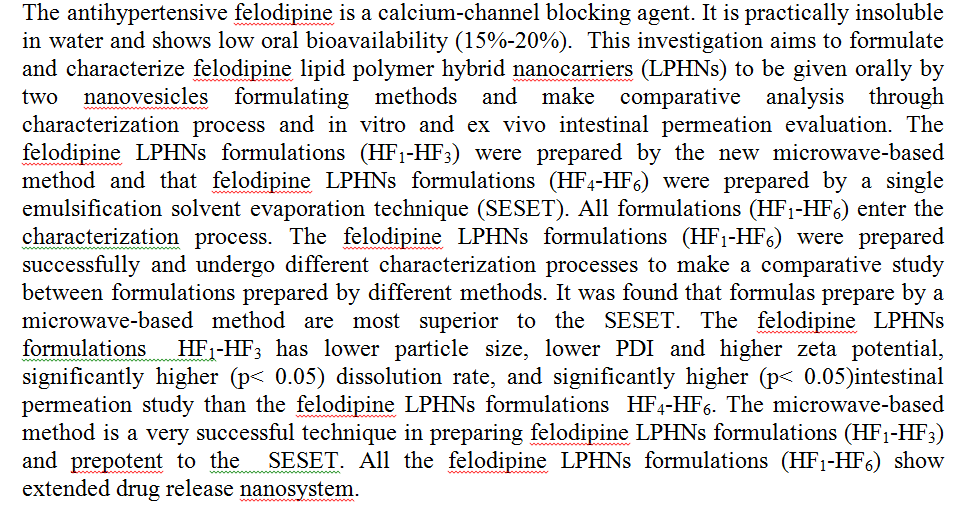ABSTRACT Background: The main goal of chemomechanical endodontic treatment is the reduction or elimination of microorganisms from root canal system. The intracanal medicaments were used to enhance the disinfection process. This study was conducted to evaluate the antibacterial effect of thymus vulgaris, tea tree essential oils and cold pressed black seed oil (BSO) against E.faecalis. Materials and methods: E.faecalis was isolated from ten patients in need for endodontic treatment. The sensitivity of E.faecalis to the tested oils was evaluated in different concentrations in agar well diffusion method and compared with calcium hydroxide. The sensitivity of E.faecalis to vapor of the tested oils was also evaluated, in disk vaporization method
... Show More (6)
(6)
Background: White spot lesions are esthetic problems caused by subsurface enamel demineralization that seen as white opacity. Aim of the study: This study aimed to evaluate and to compare the color change after the treatment of the white spot lesions with resin ‹nϔ‹Žtrƒt‹on and micro abrasion. Materials and Methods: rt‹ϔ‹…‹ƒŽ white spot lesions were generated on 48 premolar teeth by the use of a demineralization solution. The teeth were randomly divided using the Diagnodent into three study groups (16 teeth for each group) depending on the depth of the induced lesions: outer enamel, inner enamel and outer dentine. Then each group was fatherly subdivided into two groups (8 teeth for each group) the ϔ‹rst group was treated wit
... Show MoreBackground: Common and persistent isolate ina the teeth following failed therapy of the root canal is the gram-positive facultative bacterium Enterococcus faecalis and Escherichia coli, which develop biofilm through a complicated process that results in the formation of a biofilm. Enterococcus faecalis and Escherichia coli are significant factors that cause chronic periradicular lesions after root canal therapy. Aim: This study aimed to treat the root canal tooth infected with Escherichia coli and Enterococcus faecalis Methods: In this study biofilm formation was done for Escherichia coli in growth phase cultured in a brain heart broth Enterococcus faecalis and Escherichia coli cultured in Luria-Bertani (LB) infusion medium for 18 hrs. Then
... Show More (1)
(1)
 (8)
(8)
Background: White spot lesion is the first visible sign of dental caries that is characterized by demineralized lesion underneath an intact surface. Several studies demonstrated that they could be treated using noninvasive techniques like the use of fluoride or casein phospho-peptide and amorphous calcium phosphate. Improvement in aesthetic outcomes by covering the demineralized enamel is one of the advantages of the use of resin infiltration and opal-ustre microabrasion, which are two new techniques that had been used for treatment of white spot lesion. The purpose of this study was to evaluate the impact of resin infiltration and microabrasion in the microhardness of the artificial white spot lesions at various depths. Material and method
... Show More (13)
(13)
 (8)
(8)
 (1)
(1)
It is well known that petroleum refineries are considered the largest generator of oily sludge which may cause serious threats to the environment if disposed of without treatment. Throughout the present research, it can be said that a hybrid process including ultrasonic treatment coupled with froth floatation has been shown as a green efficient treatment of oily sludge waste from the bottom of crude oil tanks in Al-Daura refinery and able to get high yield of base oil recovery which is 65% at the optimum operating conditions (treatment time = 30 min, ultrasonic wave amplitude = 60 micron, and (solvent: oily sludge) ratio = 4). Experimental results showed that 83% of the solvent used was recovered meanwhile the main water
... Show More (1)
(1)
Cryptography algorithms play a critical role in information technology against various attacks witnessed in the digital era. Many studies and algorithms are done to achieve security issues for information systems. The high complexity of computational operations characterizes the traditional cryptography algorithms. On the other hand, lightweight algorithms are the way to solve most of the security issues that encounter applying traditional cryptography in constrained devices. However, a symmetric cipher is widely applied for ensuring the security of data communication in constraint devices. In this study, we proposed a hybrid algorithm based on two cryptography algorithms PRESENT and Salsa20. Also, a 2D logistic map of a chaotic system is a
... Show More (30)
(30)
 (15)
(15)
The important factor in the success of construction projects is its ability to objective estimate of the cost of the project and adapt to the changes of the external environment, which is affected by a lot of elements and the requirements of the competitive environment. The faces of those projects are several problems in order to achieve particular goals. To overcome these difficulties has been the development of research in the last two decades and turn the focus on the role of the cost of project management, by providing information and assist management in planning and control of the budget among the main elements of the project, namely, (time-cost-quality),The research aims at the possibility of developing and implementing mechanisms
... Show More
